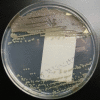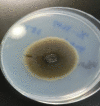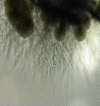Exophiala dermatitidis
- PMID: 34621853
- PMCID: PMC8462220
- DOI: 10.12998/wjcc.v9.i27.7963
Exophiala dermatitidis
Abstract
Exophiala is a genus comprising several species of opportunistic black yeasts, which belongs to Ascomycotina. It is a rare cause of fungal infections. However, infections are often chronic and recalcitrant, and while the number of cases is steadily increasing in both immunocompromised and immunocompetent people, detailed knowledge remains scarce regarding infection mechanisms, virulence factors, specific predisposing factors, risk factors, and host response. The most common manifestations of Exophiala infection are skin infections, and the most frequent type of deep infection is pulmonary infection due to inhalation. The invasive disease ranges from cutaneous or subcutaneous infection to systemic dissemination to internal organs. The final identification of the causative organism should be achieved through a combination of several methods, including the newly introduced diagnostic analysis, matrix-assisted laser desorption/ionization-time-of-flight mass spectrometry, together with sequencing of the ribosomal ribonucleic acid internal transcribed spacer region of the fungi, and histological and culture findings. Regarding treatment, because anti-infective agents and natural compounds exhibited poor antibiofilm activity, few treatments have ultimately been found to be effective for specific antifungal therapy, so the optimal antifungal therapy and duration of therapy for these infections remain unknown. Therefore, most forms of disease caused by Exophiala dermatitidis require aggressive combination therapies: Both surgical intervention and aggressive antifungal therapy with novel compounds and azoles are necessary for effective treatment.
Keywords: Antifungal drugs; Black yeast; Exophiala dermatitidis; Immunocompromised host; Matrix-assisted laser desorption/ionization-time-of-flight mass spectrometry; Ribosomal ribonucleic acid.
©The Author(s) 2021. Published by Baishideng Publishing Group Inc. All rights reserved.
Conflict of interest statement
Conflict-of-interest statement: The authors declare that they have no conflict of interest.
Figures




References
-
- Bahadori T, Didehdar M, Khansarinezhad B, Shokohi T. Identification of opportunistic and nonopportunistic Exophiala species using high resolution melting analysis. Med Mycol. 2020;58:938–945. - PubMed
-
- Babič MN, Zupančič J, Gunde-Cimerman N, de Hoog S, Zalar P. Ecology of the Human Opportunistic Black Yeast Exophiala dermatitidis Indicates Preference for Human-Made Habitats. Mycopathologia. 2018;183:201–212. - PubMed
-
- Brandt ME, Warnock DW. Epidemiology, clinical manifestations, and therapy of infections caused by dematiaceous fungi. J Chemother. 2003;15 Suppl 2:36–47. - PubMed
-
- Döğen A, Kaplan E, Ilkit M, de Hoog GS. Massive contamination of Exophiala dermatitidis and E. phaeomuriformis in railway stations in subtropical Turkey. Mycopathologia. 2013;175:381–386. - PubMed
-
- Zalar P, Novak M, de Hoog GS, Gunde-Cimerman N. Dishwashers--a man-made ecological niche accommodating human opportunistic fungal pathogens. Fungal Biol. 2011;115:997–1007. - PubMed
Publication types
LinkOut - more resources
Full Text Sources

